power steering AUDI R8 SPYDER 2014 Owners Manual
[x] Cancel search | Manufacturer: AUDI, Model Year: 2014, Model line: R8 SPYDER, Model: AUDI R8 SPYDER 2014Pages: 244, PDF Size: 61.06 MB
Page 5 of 244
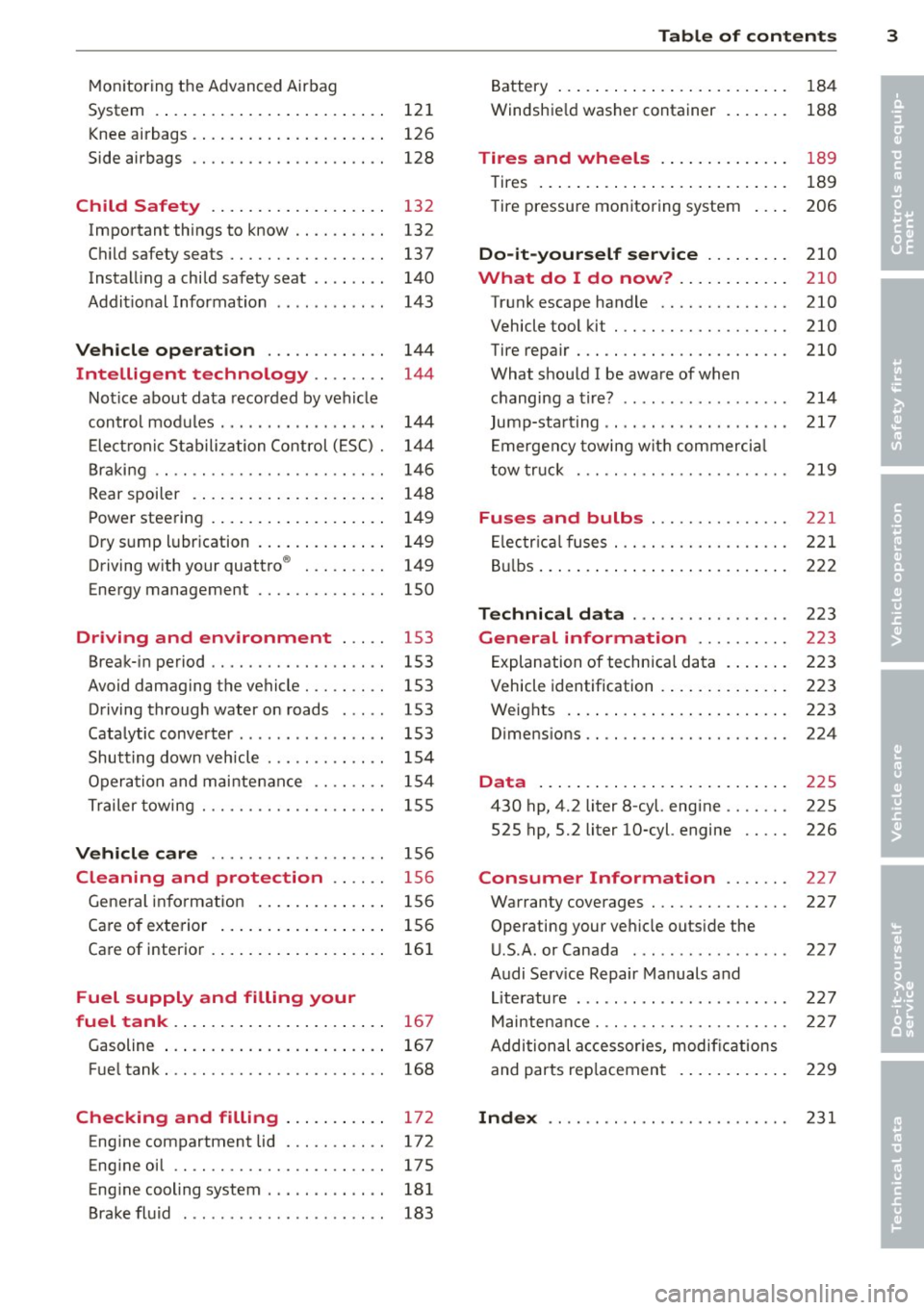
Monitoring the Advanced Airbag
System . . . . . . . . . . . . . . . . . . . . . . . . . 121
Knee airbags . . . . . . . . . . . . . . . . . . . . . 126
Side airbags . . . . . . . . . . . . . . . . . . . . . 128
Child Safety . . . . . . . . . . . . . . . . . . . 132
Important things to know . . . . . . . . . . 132
C hild safety seats . . . . . . . . . . . . . . . . . 137
Installing a child safety seat . . . . . . . . 140
Additional Information . . . . . . . . . . . . 143
Vehicle operation . . . . . . . . . . . . . 144
Intelligent technology . . . . . . . . 144
Notice about data recorded by vehicle
control modules . . . . . . . . . . . . . . . . . . 144
E lect ronic Stabilization Control (ES C) . 144
B raking . . . . . . . . . . . . . . . . . . . . . . . . . 146
Rear spoiler . . . . . . . . . . . . . . . . . . . . . 148
Power steering . . . . . . . . . . . . . . . . . . . 149
Dry sump lub rication . . . . . . . . . . . . . . 149
Driving with your quattro ® . . . . . . . . . 149
Energy management . . . . . . . . . . . . . . 150
Driving and environment . . . . . 153
Break- in period . . . . . . . . . . . . . . . . . . . 153
Avoid damaging the vehicle . . . . . . . . . 153
Driving through water on roads . . . . . 153
Catalytic converter . . . . . . . . . . . . . . . . 153
Shutting down veh icle . . . . . . . . . . . . . 154
Operation and maintenance . . . . . . . . 154
Trailer towing . . . . . . . . . . . . . . . . . . . . 155
Vehicle care . . . . . . . . . . . . . . . . . . . 156
Cleaning and protection . . . . . . 156
General information . . . . . . . . . . . . . . 156
Care of exterior . . . . . . . . . . . . . . . . . . 156
Care of interior . . . . . . . . . . . . . . . . . . . 161
Fuel supply and filling your
fuel tank . . . . . . . . . . . . . . . . . . . . . . .
167
Gasoline . . . . . . . . . . . . . . . . . . . . . . . . 167
Fuel tank. . . . . . . . . . . . . . . . . . . . . . . . 168
Checking and filling . . . . . . . . . . . 172
Eng ine compartment lid . . . . . . . . . . . 172
Eng ine oil . . . . . . . . . . . . . . . . . . . . . . . 175
Eng ine cooling system . . . . . . . . . . . . . 181
Brake fluid . . . . . . . . . . . . . . . . . . . . . . 183
Table of contents 3
Battery ... .. .... ... .. .......... . 184
Windshield washer container
188
•
•
Tires and wheels ........... .. . 189
Tires ..... .. .... ... .. .......... .
189
Tire pressure monitoring system
206
Do-it-yourself service ........ . 210
What do I do now? ........... . 210
Tr unk escape handle ........... .. .
210
Vehicle tool kit . .. ............... .
210
Tire repair . .. .. .. ............... .
210
What should I be aware of when
h . t· 7 c
anging a rre . . .. .............. . 214
Jump-starting .. .. ... .. .. ... ..... . 217
Em ergency towing with commercial
tow truck ... .. .. .. . ............ . 219
Fuse s and bulbs ... ........... . 221
El ectr ical fuses . .. ............... . 221
Bulbs ..... .. .. .. .. .. ........... . 222
Technical data ..... ........... . 223
General information ......... . 223
Explanation of technical data ...... . 223
Vehicle identification ........... .. .
223
Weights .. .. .. .... .. ........... .
223
Dimens ions .. .. ...... ........... . 224
Data ..... .. .... .. . .. .......... . 225
430 hp, 4.2 liter 8-cyl. engine ...... .
225
525 hp, 5.2 liter 10-cyl. engine .... .
226
Con sumer Information ...... . 227
Warranty coverages .............. . 227
Operating your vehicle outside the
U .S.A . or Canada ... . .. .. ...... .. . 227
Audi Serv ice Repair Manuals and
literature ... .. .. .. . .. .. ..... ... . 227
Maintenance . .. .. ............... . 227
Additional accessories, modifications
and parts replacement . . . . . . . . . . . . 229
Index . . . . . . . . . . . . . . . . . . . . . . . . . . 231
Page 9 of 244
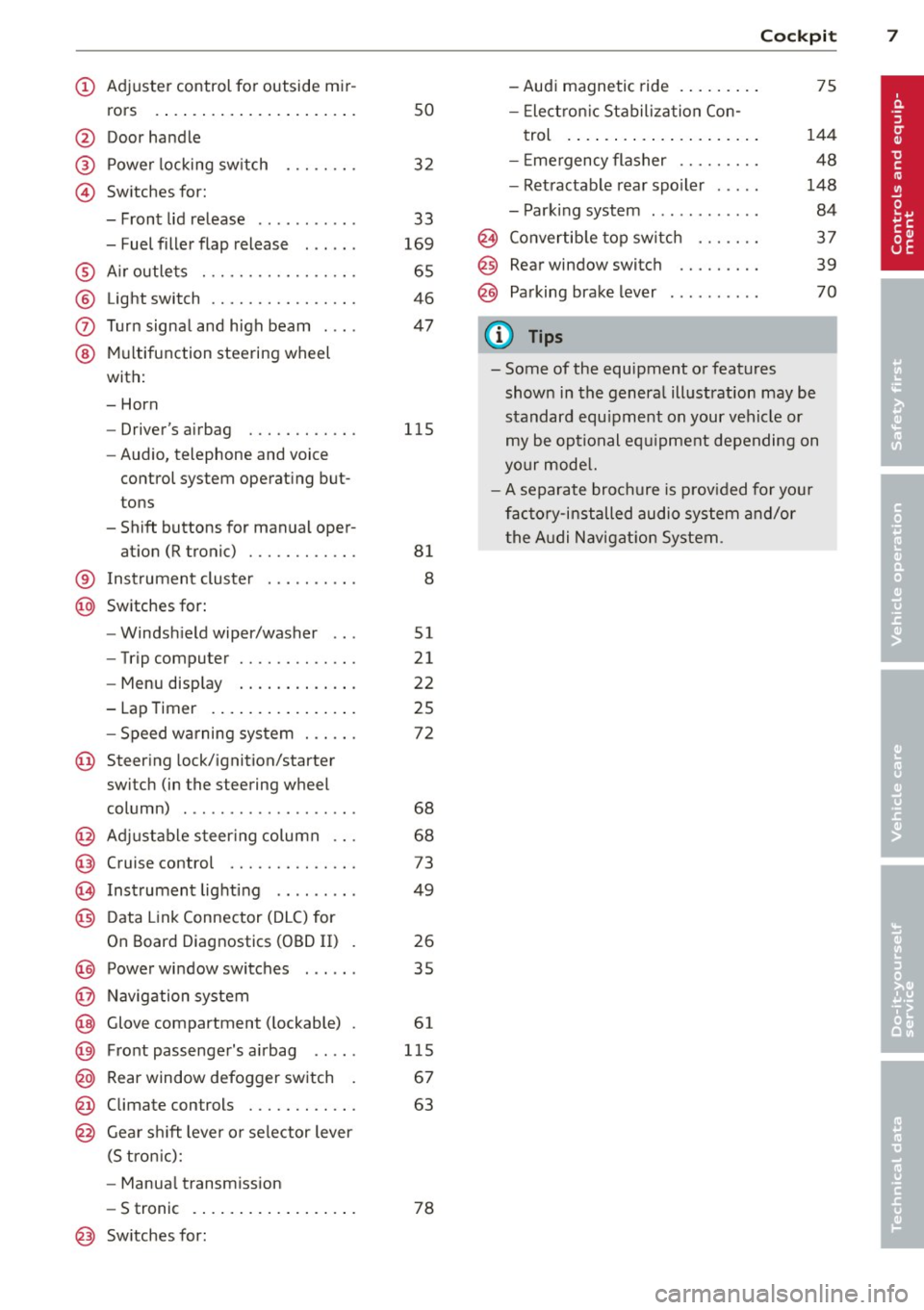
(!) Adjuster control for outside mir-rors .... ..... .......... .. .
@ Door handle
@ Power locking switch
© Switches for:
- Front lid release .......... .
- Fuel filler flap release . .. .. .
® Air outlets ............ .... .
® Light switch ............... .
(J) Turn signal and high beam ... .
@ Multifunction steering wheel
with:
- Horn
- Driver's airbag ........... .
- Audio, telephone and voice
control system operating but
tons
- Shift buttons for manual oper-
at ion (R tronic) ........... .
® Instrument cluster
@ Switches for:
so
32
33
169
65
46
47
115
81
8
- Windshield wiper/washer 51
- Trip computer . . . . . . . . . . . . . 21
- Menu display . . . . . . . . . . . . . 22
- Lap Timer . . . . . . . . . . . . . . . . 25
- Speed warning system . . . . . . 72
@ Steering lock/ignition/starter
switch (in the steering wheel
column) . . . . . . . . . . . . . . . . . . . 68
@ Adjustable steering column . . . 68
@ Cruise control . . . . . . . . . . . . . . 73
@ Instrument lighting . . . . . . . . . 49
@) Data Link Connector (DLC) for
On Board Diagnostics (OBD II) 26
@) Power window switches . . . . . . 35
@ Navigation system
@ Glove compartment (lockable) 61
@ Front passenger's airbag . . . . . 115
@ Rear window defogger switch 67
@ Climate controls . . . . . . . . . . . . 63
@ Gear shift lever or selector lever
(5 tronic):
- Manual transmission
- 5 tronic . . . . . . . . . . . . . . . . . . 78
@ Switches for:
Cockpit 7
-Audi magnetic ride ........ . 75
-Electronic Stabilization Con-
trol . . . . . . . . . . . . . . . . . . . . . 144
- Emergency flasher . . . . . . . . . 48
- Retractable rear spoiler . . . . . 148
- Parking system . . . . . . . . . . . . 84
@ Convertible top switch . . . . . . . 37
@ Rear window switch . . . . . . . . . 39
@ Parking brake lever . . . . . . . . . . 70
(D Tips
-Some of the equipment or features
shown in the general illustration may be
standard equipment on your vehicle or
my be optional equipment depending on
your model.
- A separate brochure is provided for your
factory-installed audio system and/or
the Audi Navigation System .
Page 71 of 244
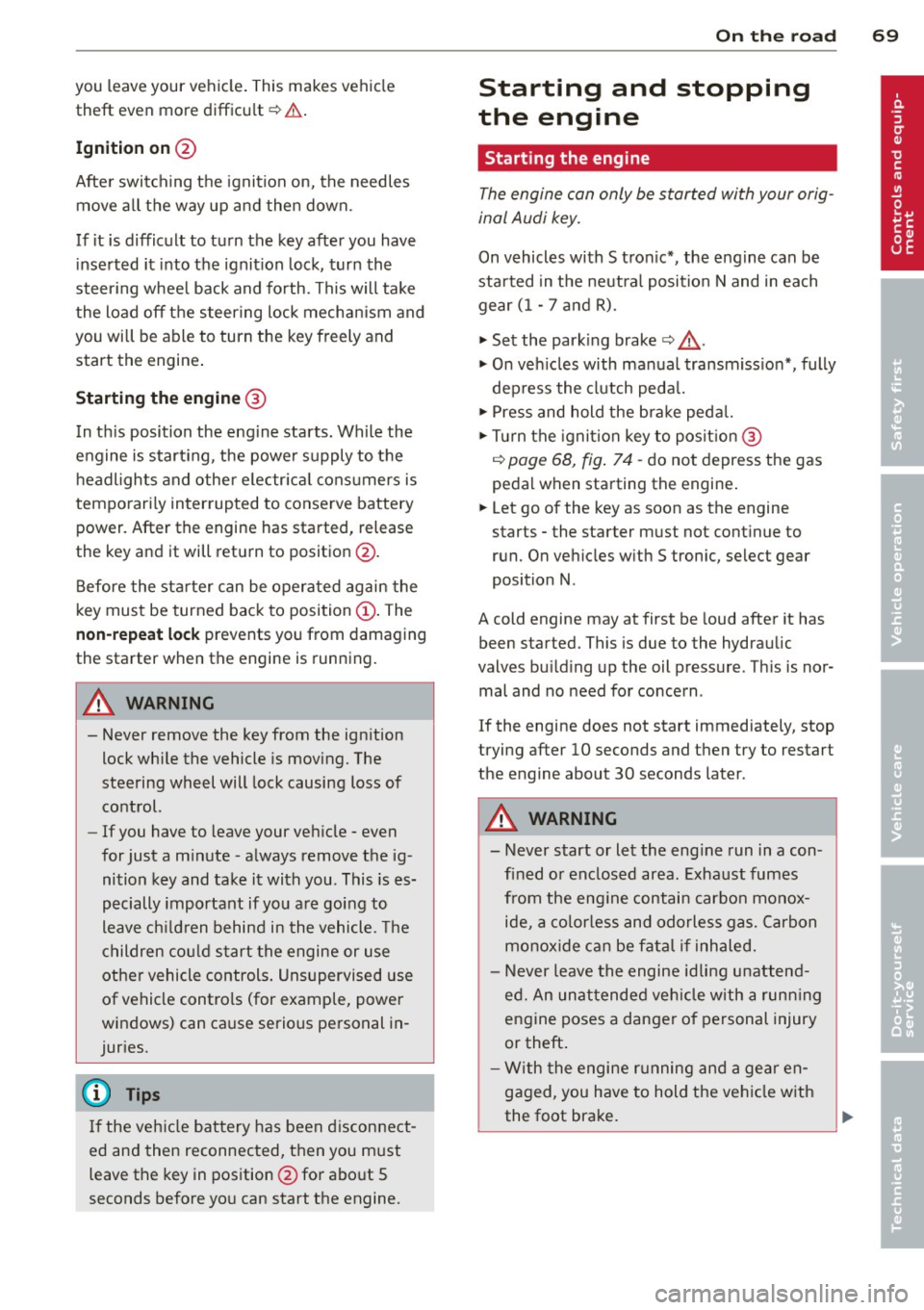
you leave your vehicle. This makes vehicle
theft even more difficu lt
r=:, .&. .
Ign ition on @
After switch ing the ignition on, the needles
move all the way up and then down.
If it is difficult to turn the key after you have inserted it into the ignit ion lock, turn the
steer ing whee l back and forth. This will take
the load
off the steering lock mechan ism and
you will be able to turn the key freely and start the engine .
Starting the engine @
In th is position the engine starts. While the
engine is start ing, the power supply to the
headlights and other e lectr ica l cons umers is
temporari ly inter rupted to conserve battery
power. After the engine has started, release
the key and it will return to position @.
Before the starter can be operated again the
key must be turned back to position
(D . The
non-repeat lock prevents you from damaging
the starter when the engine is running.
A WARNING
- Never remove the key from the ign ition
lock while the vehicle is moving. The
steering wheel will lock causing loss of
control.
- If you have to leave your veh icle - even
for just a m inute - a lways remove the ig
nition key and take it with you. This is es
pecially important if you a re going to
leave ch ildren behind i n the vehicle. The
children co uld s tart the engine or use
other vehicle controls . Unsupervised use
of vehicle controls (for example, power
windows) can cause serious personal in
juries.
@ Tips
I f the veh icle bat tery has been d isconnect
ed and then reconnected, then you must
leave the key in pos ition @for abo ut 5
seconds before you can start the engine.
-
On th e ro ad 69
Starting and stopping
the engine
Starting the engine
The engine can only be started with your orig
inal Audi key.
On vehicles with S tron ic*, the e ngine can be
sta rted in the neut ra l position N and in each
gear (1 - 7 a nd R).
" Set the park ing brake
r=:, & .
"On veh icles with manual transmiss ion*, fully
dep ress the clutch peda l.
" Press and hold the brake peda l.
" Tur n the igni tion key to pos it ion @
r=:> page 68, fig . 74 -do not depress the gas
peda l when sta rting the engine .
... Let go of the key as soon as the engine
starts - the starter m ust not cont inue to
run. On vehicles w ith S tronic, select gear
position N.
A cold engine may at first be loud after it has
been started. This is due to the hydraulic
valves bu ild ing up the oil p ressure . Th is is nor
mal and no need for concern .
If the engine does not start immediately, stop
trying after 10 seconds and then try to restart
the engine about 30 seconds later .
A WARNING
- Never start or let the engine run in a con
fined or enclosed area. Exhaust fumes
from the eng ine contain carbon mono x
ide, a co lor less and odorles s gas. Carbon
monox ide can be fata l if inh aled.
- Never leave the engine id ling una ttend
ed. An unat tended ve hicle with a runn ing
engine poses a danger of personal injury
or theft .
- With the engine r unning and a gear en
gaged, you have to hold the veh icle w ith
the foot bra ke.
Page 146 of 244
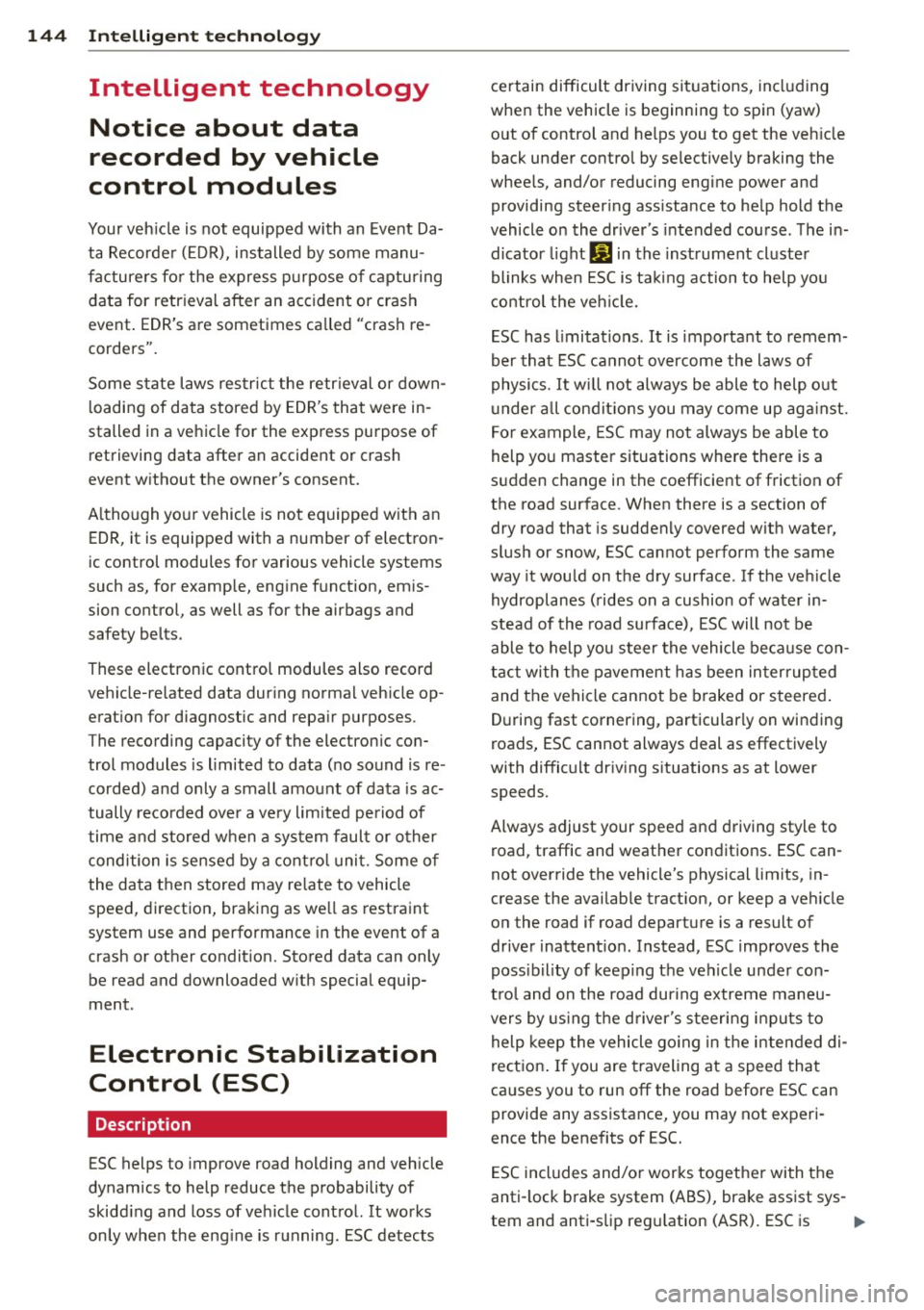
144 Intelligent technology
Intelligent technology
Notice about data
recorded by vehicle
control modules
Your veh icle is not equipped with an Event Da
ta Recorde r (EDR), ins talled by some manu
facture rs fo r the express p urpose of capturing
data for retrieval after an accident or cras h
event . EDR's are sometimes ca lled "crash re
corders".
Some state laws restr ict the retr ieval or down
loading of data stored by EDR's that were in
stalled in a vehicle for the express purpose of retrieving data after an accident or crash
event without the owner's consent.
A ltho ugh yo ur vehicle is not equ ipped wit h an
EDR, it is equipped with a number of electron
ic control modules for various v ehicle systems
such as, for examp le, eng ine f unction, em is
sion control, as well as for the airbags and
sa fety belt s.
These electronic contro l modules also record
vehicle-re lated data during norma l vehicle op
erat ion for diagnostic and repa ir purposes.
T he recording capacity of the electronic con
trol modules is limited to data (no sound is re
corded) and only a small amount of data is ac
tually recorded ove r a ve ry limited pe riod of
time and stored when a sys tem faul t or o ther
cond ition is sensed by a cont ro l u nit. Some of
the data then stored may re late to vehicle
speed, direction, braking as we ll as restraint
system use and performance in the event of a
crash or other condit ion. Stored data can only
be read and downloaded w ith special equip
ment .
Electronic Stabilization
Control (ESC)
Description
ESC helps to improve road holding and vehicle
dynamics to help reduce the probability of
skidd ing and loss of ve hicle control. It works
only when the eng ine is running . ESC detects certain difficult driving situat
ions, including
when the vehicle is beginning to spin (yaw)
o ut of control and he lps you to get the veh icle
back under control by se lectively braking the
whee ls, and/or reducing eng ine power and
providing steer ing ass istance to he lp hold the
vehicle o n the dr iver's intended course . T he in
dicator light
G) in the inst rument cluster
blinks when ESC is ta king action to help yo u
control the veh icle.
ESC has limitations.
It is importa nt to remem
ber that ESC cannot overcome the laws of
physics. It wi ll not always be able to help out
under a ll cond it ions you may come up aga inst.
F or example, ESC may not always be able to
help you master situations where there is a
s u dden change in the coefficient of friction of
the road surface . When there is a section of
dry road that is sudden ly covered w ith water,
s lush or snow, ESC cannot perform the same
way it wou ld on the dry surface . If the ve hicle
hydroplanes (rides on a cushion of water in
stead of the road surface), ESC will not be
able to help you steer the vehicle because con
tact with the pavement has been in terrupted
and the vehicle cannot be braked or steered .
D uring fast cornering, particularly on winding
roads, ESC cannot always deal as effectively
with difficult driving situations as at lower
speeds.
Always adjust your speed and driving style to road , traffic and weather conditions. ESC can
not override the vehicle's physical limits, in
crease the available tract ion, or keep a ve hicle
on the road if road departure is a result of
driver inattent ion . Instead, ESC imp roves the
poss ib ility of keep ing the veh icle under con
t rol and on the road during extreme maneu
vers by using the d river 's steering inputs to
help keep the vehicle go ing in t he i nte nded di
rection . If you are t raveling at a speed tha t
ca uses you to run off the road before ESC can
provide any assistance, you may not experi
ence the benefits of ESC.
ESC includes and/o r works togethe r with the
anti- lock b rake system (ABS), brake assist sys-
tem and anti-slip reg ulation (ASR). ESC is .,..
Page 151 of 244

Power steering
When the engine is running, power steering
makes it easier for the driver to steer.
Power steering he lps the driver steer the vehi
cle with little physical effort .
If the engine is not runn ing, the power steer
ing system is also not wo rking. In this case,
you will find it extreme ly difficult to turn the
steering whee l.
If you t urn t he steering fully to the le ft or
right when the vehicle is stationary, you place
a very heavy load on t he power steering sys
tem . T urning the steering wheel fu lly to the
left or r ight will cause noise in the system . It
a lso reduces engine idle speed.
(D Note
Do not hold the steering turned fully to
the left or right for more than 10 seconds
when t he engine is running. There is a risk
of damage to the power steeri ng system .
@ Tips
-In the event of a power steering system
failure, or if the eng ine is not running
(while being towed), you wi ll st ill be able
to stee r the ve hicle . However, you will re
quire more effort to do so .
- If the power steer ing system has a leak
or is defective, you should immed iately
contact a qualif ied wo rkshop.
- The powe r stee ring system requires a
spec ial hyd raulic f luid. The powe r stee r
i ng fl uid reservo ir is lo cated in the en
g ine compar tment . Th e cor re ct hydra ulic
f lui d leve l is important for p ro per opera
tion o f the power steering sys tem . The
power steer ing fl uid leve l is checked ac
cord ing to the Aud i maintenance service
schedule.
Dry sump Lubrication
H igh lateral and long itud inal forces affect the
engine and the vehicle d uring sporty driving.
Ory sump lubr ication ensures that your eng ine
Int ellig ent technolog y 149
is supplied wi th oi l and properly lubricated
even under these conditions .
In a "no rma l" veh icle the o il pump sends the
o il from the o il p an t o the lubr ication points in
t h e engine. The oi l then ret urns to the o il pan .
In extreme situations , the oil p ump may draw
in a ir, which results in insufficient oi l pressure.
Wi th dr y sump lubri cat ion, the o il is not in the
oi l pan (it is "dry"), but in a separate oil tank.
While one p ump supplies t he e ngine with oil ,
a second pump suctions the oil out of the en
gine and returns it to the oil tank. Because the
o il tank is tall and narrow, oil pressure is con
stant even under extreme conditions .
In add ition, the oi l pan in vehicles with dry
sump l ubrication is noticeab ly shallower. This
allows the engine to be installed lower in the
vehicle , bring ing down the center of grav ity .
T his imp roves your ve hicle's handling .
Driving with your
quattro ®
With all-wheel drive, all four wheels are driv
en.
General information
With a ll-wheel d rive, powe r is distr ib uted to
al l four wheels. This happens autom atic ally
depen ding on your d riving s tyle and the ro ad
conditions a t the time . See also ¢
page 144.
The all-whee l dr ive concept is des igned for
high eng ine power. Your veh icle is except ion
al ly powe rf ul and h as ex cellen t driving charac
teristics both under normal driving cond itions
and on snow and ice . Always read and follow
safety precaut ions ¢&. .
Winter tires
When dr iving in the win ter, yo ur vehicle wi th
a ll- wheel d rive h as an advantage, even w it h
regular tires. In winter road conditions it may
be advisable to mount winter tires (or all-sea
son tires) for improved driveability and brak
ing : these tires must be mounted on
all four
wheels . See also¢ page 203, Winter tires. .,..
•
•
Page 176 of 244
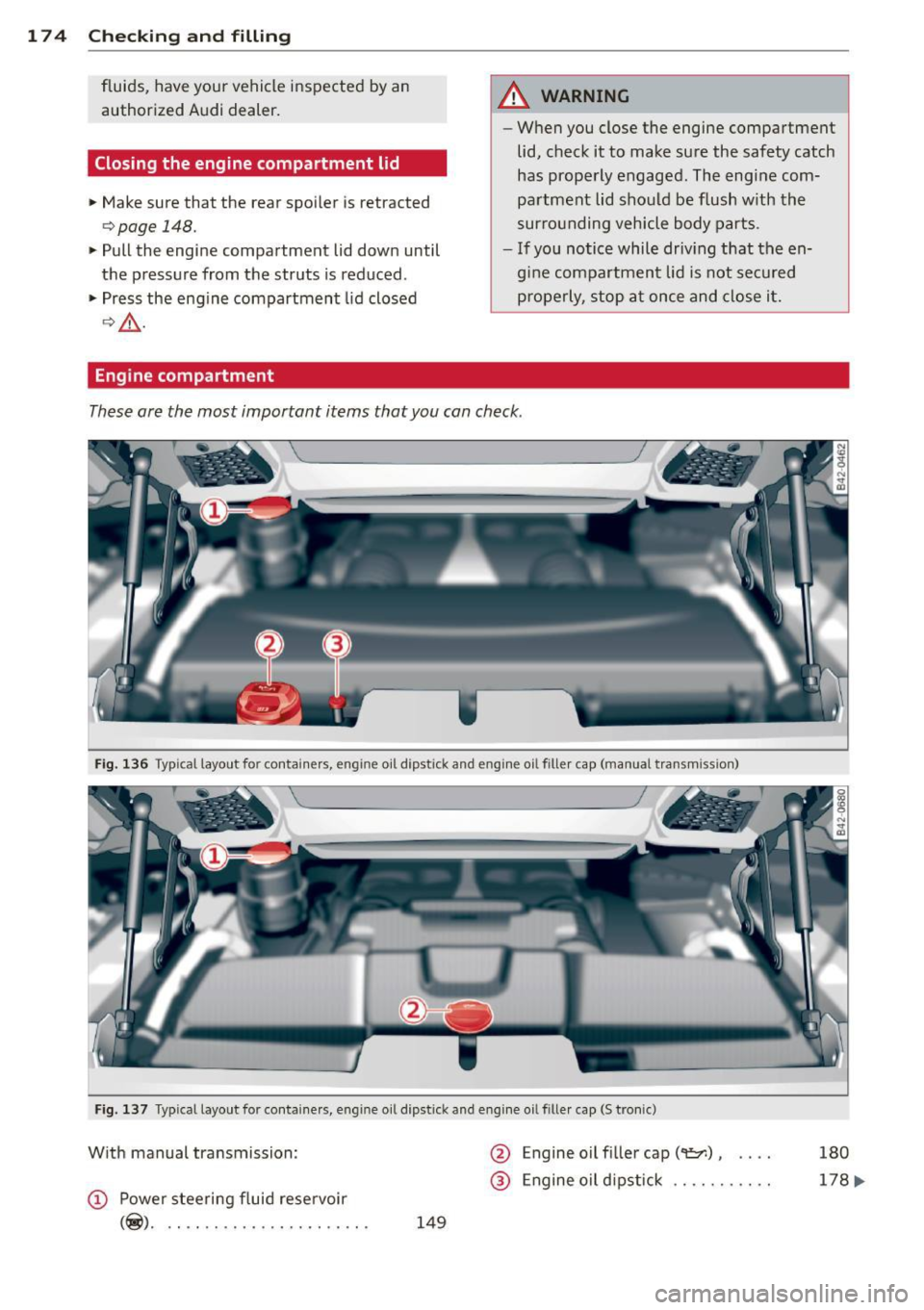
17 4 Che cking and filling
fluids, have your vehicle inspected by an
authorized Audi dealer.
Closing the engine compartment lid
.. Make sure that the rear spo iler is retracted
¢ page 148.
.. Pull the engine compa rtment lid dow n until
the p ress ure from the struts is reduced .
.. Pr ess the eng ine compartment lid closed
¢ &_ .
Eng ine compartment
A WARNING
-- W hen you close the engine compartment
lid, chec k it to make su re the safety catch
has prope rly engaged . The engine com
pa rtment lid s ho ul d be flush w ith the
sur ro un ding vehicle body parts .
- If you notice while driv ing t hat the en
g in e compartmen t lid is not secu red
p roperly, sto p at once and cl ose it .
These ore the most important items that you con check .
Fig . 136 Ty pica l layout fo r co ntai ners , e ngin e o il dipst ick and engin e o il fille r cap (man ual t ra n sm iss io n)
F ig . 1 37 Typ ica l layout fo r co ntain ers, e ngin e o il d ipstic k and e ng in e o il fill er cap (S t ro nic )
W ith manual transmission: @ Engine oil f iller cap(~) ,
(D Power steering f luid rese rvoir
@ E ngine o il d ipst ick ...... .... .
(@) ... .... .... ....... .. .. . 14 9
180
178 ....
Page 192 of 244

190 Tire s and wheel s
-Never mount used tires on yo ur vehicle if
yo u are not sure of their "previous histo
ry." Old used tires may have been dam
aged even though the damage cannot be
seen that can lead to sudden t ire failure
and loss of vehicle control.
- If you notice unusual vibration or if the
vehicle pulls to one side when driving, al
ways stop as soon as it is safe to do so
and check the wheels and tires for dam
age.
(D Note
Please note that summer and winter tires
are designed for the cond itions that are
Glossary of tire and loading terminology
Accessory weight
means the comb ined we ight (in excess of
those standard items which may be rep laced)
of au toma tic tra nsmission, power steer ing,
power brakes, power windows, power seats,
radio, and heater, to the extent that these
items are availab le as factory -installed equip
ment (whether installed or not) .
Aspect ratio
means the ratio of the he ight to the w idth of
the tire in percent . Numbers of 55 or lower in
dicate a low sidewall for improved steering re
sponse and better overall handling on dry pavement .
Bead
means the part of the ti re that is made of
steel wires, wrapped or reinforced by ply cords
and that is shaped to fit the rim.
Bead s eparation
means a b reakdown of the bond between
components in the bead.
Cord
means the strands forming the plies in the
tire . typ
ica l in those seasons . Audi recommends
using winter tires during the winter
months . Low temperatures signif icant ly
decrease the e lasticity of summer tires,
which affects tract ion and brak ing ability.
If summer tires are used in very co ld tem
peratures, cracks ca n form on the tread
bars, res ulting in permanent tire damage
that can cause loud driving no ise and un
balan ced t ires. Audi is not responsible for
th is type of damage .
Cold tire inflation pre ssure
means the t ire p ressure recommended by the
vehicle manufacturer fo r a tire of a des ignated
s ize that has not bee n driven for more than a
coup le of miles (k ilometers) at low speeds in
the three hour period before the tire pressure
is measured or adjusted.
Curb weight
means the we ight of a motor ve hicle w ith
standard equipment including the max imum
capacity of fuel, oil, and coolant, air condi
tioning and additional weight of optiona l
equipment.
E x tra load tire
means a t ire designed to ope rate a t higher
loads and at highe r inflation p ressu res than
the corresponding standard tire. Extra load
tires my be identified as "XL", "xl", "EXTRA
LOAD", or "RF" on the sidewall.
Gross A xle Weight Rating ("GAWR ")
means the load -carry ing capacity of a s ingle
axle system , measured at the tire-ground in
terfaces.
Gr oss Vehicle Weight Rating ("GVWR ")
means the maximum total loaded we ight of
t h e vehi cle. .,.
Page 224 of 244
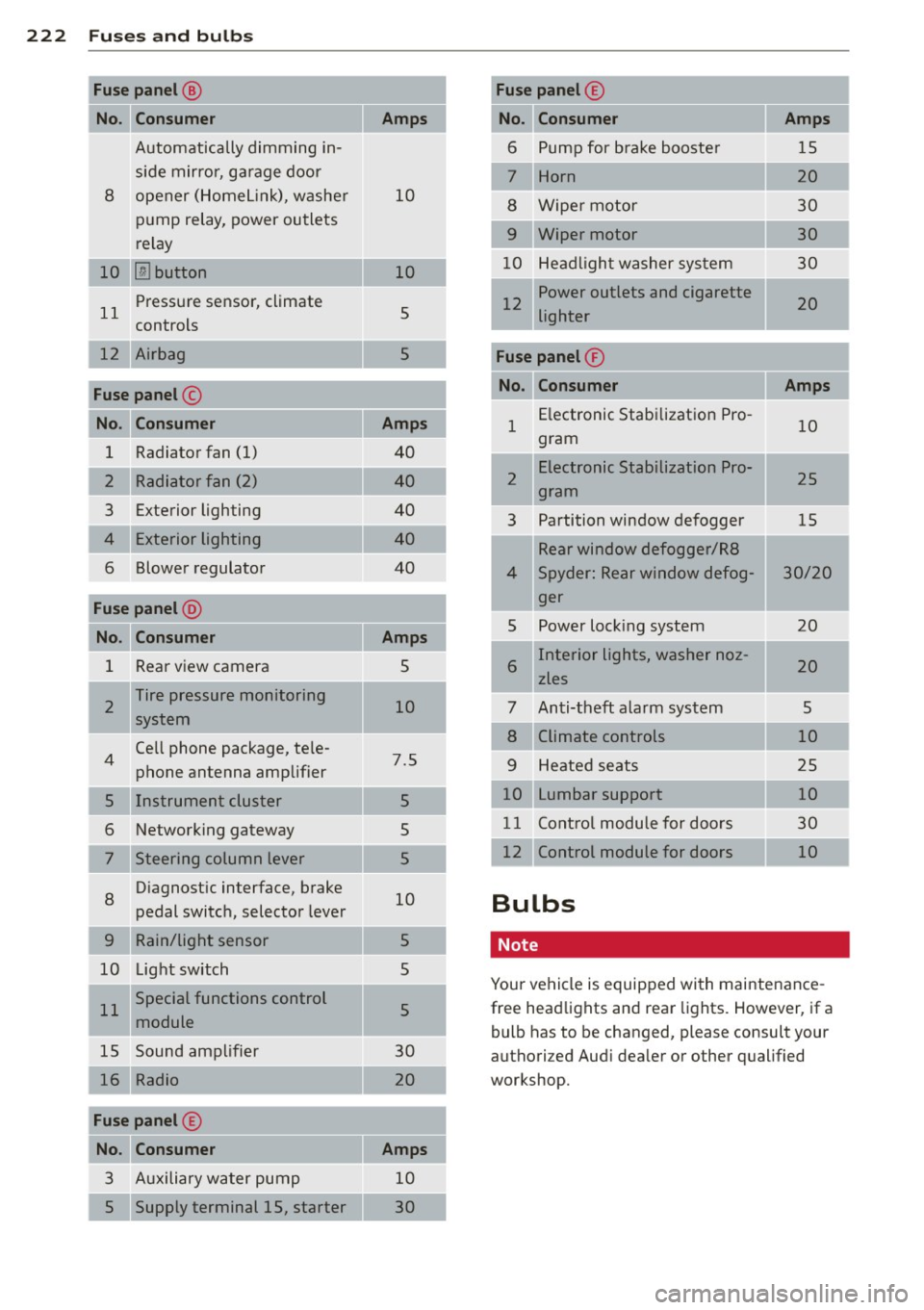
222 Fuses and bulbs
Fuse panel @
Consumer Amps
Automatically dimming in-
side mirror, garage door
8 opener (Homel
ink), washer
10
pump relay, power outlets
relay
10
[ru button 10
11 Pressure sensor, climate
5
controls
12 Airbag 5
Fuse panel@
No . II Consumer
II Amps
1 Radiator fan (1)
40
2 Radia
tor fan (2)
40
3 Exterior lighting
40
4 Exterior lighting 40
6 Blower regulator 40
Fuse panel@
No . II Consumer
II Amps
1 Rear view camera
5
2
Tire pressure monitoring
system 10
4 Cell phone package, te
le-
7.5
phone antenna amplifier
5 Instrument cluster 5
6 Networking gateway
5
7 Steering column lever 5
8 Diagnostic interface, brake
10
pedal switch, selector lever
9 Rain/light sensor 5
10 Light switch 5
11 Special functions control
5
module
15 Sound amplifier 30
Radio 20
Fuse panel E
No. Consumer Amps
3 Auxiliary water pump 10
5 Supply terminal 15, starter 30
Fuse panel @
No. Consumer Amps
6 Pump for brake booster 15
7 Horn
20
8 Wiper motor 30
9 Wiper motor
30
10 Headlight washer system 30
12 Power outlets and cigarette
20
lighter
Fuse panel ®
No. !!Consumer
ll Amps ,
1 E
lectronic Stabilization Pro -
10
gram
2 Electronic
Stabilization Pro-
25
gram
3 Partition window
defogger
15
Rear window defogger/RB
4 Spyder: Rear window defog- 30/20
ger
5 Power lock
ing system 20
6
Interior Lights, washer noz-20
zles
7 Anti-theft alarm system 5
8 Climate controls 10
9 Heated seats 25
10 Lumbar support 10
11 Control module for doors 30
12 Control module for doors
10
Bulbs
Note
Your vehicle is equipped with maintenance
free headlights and rear lights. However, if a
bulb has to be changed, please consult your
authorized Audi dealer or other qualified
workshop.
Page 239 of 244

Polishing .... ... .......... .. .. .. ... 156
Pollen filter . . . . . . . . . . . . . . . . . . . . . . . . . 64
P ower locking system . . . . . . . . . . . . . . . . . 3 0
Emergency locking ........ .. .. .. .. .. 33
Front lid . . . . . . . . . . . . . . . . . . . . . . . . . . 3 3
Lock ing .. ..... ....... .... ... ... ... 32
Lock ing and unlocking the vehicle from
in side ... .. .... ............. .. .. .. 3 2
Sw itches . .. .. ........... .. .. .. .... 3 2
Un loc kin g .. ............. .. .. .. .. .. 32
Un loc king and locking vehicle ... .. .. .. 31
Powe r seats . . . . . . . . . . . . . . . . . . . . . . . . . 58
Power steering . . . . . . . . . . . . . . . . . . . . . 149
P ower windows ............ .... .. .... 35
Reac tiva ting the system ... .. .. .. .. .. 36
Pregnant women Specia l cons iderations when weari ng a
safety be lt . ............. .... .. ... 108
Programming the Homelink ® universal re
mote contro l . . . . . . . . . . . . . . . . . . . . . . . . 90
Proper safety belt pos ition ... .. .. .. .. . 107
P rope r seat ing pos it ion
D river ... .. .. ............. .. .. .... 94
Fr ont passenge r .......... .. .. .. .. .. 95
Q
Quartz clock . . . . . . . . . . . . . . . . . . . . . . . . . 9
Question What happens to unbelted occupants? 104
Why safety belts? .............. ... 103
R
Rain sensor defect ive ....... .. .. .. .. .. 19
Rear light Defective .. .. .. .. .... ... .. .. .. .... 18
Rear spoiler . . . . . . . . . . . . . . . . . . . . . . . . 148
Rear view camera Parallel Parking .......... .. .. .. .. .. 87
Reverse pa rking ..... ..... .. .. .. .. .. 87
Rear view mirror . . . . . . . . . . . . . . . . . . . . . 50
Rear window . .. ........... .. .. .. .... 39
Rear window defogger . . . . . . . . . . . . . . . . 67
Refueling .... .. ... ..... ... .. .. .. ... 169
Remote control . . . . . . . . . . . . . . . . . . . . . . 32
also refer to Remote mast er key . . . . . . . 29
Inde x 237
Remote contro l garage door opener
(Homelink®) . ... .... . ... ...... ... .. . 90
Remote maste r key
B attery replacement . . . . . . . . . . . . 28, 29
Check lig ht .. .. .. ................. . 28
U nlocking and locking ... .... ... .. .. . 31
Repa ir man uals .. .. .. ............... 227
Repairs Airbag system 124
Rep lacement parts ... . .. ..... ... .. . . 229
Replacing Bu lbs ........ ... .. ..... ......... . 222
F uses ... .. .... .. .. . .............. 221
Rims ..... .. .. .. .. .. ........... .. 199
T ires and wheels ... .. .. .... ... .. .. 200
Wheel rims . ..... ... .. .. ..... ... .. 201
Repo rting Safety Defects . . . . . . . . . 99, 100
Reset button . . . . . . . . . . . . . . . . . . . . . . . . 10
Resetting remote cont ro l . . . . . . . . . . . . . . 32
Retractor ......... .. ............... 106
Reve rse gear (S tronic) . . . . . . . . . . . . . . . . 78
R ims
Rep laci ng . . . . . . . . . . . . . . . . . . . 199, 201
Rollbar
refer to Active rollover protection sys-
tem ......... ... .. ............... 101
s
SAFE 10,29
Safe driving habits ... . .. .. ..... ... .. . 93
Safety be lt pos ition ............. .... 10 7
Safety be lts wo rn by pregnan t women 108
Safety be lt p retensioner
Serv ice and d isposa l .............. . 109
Safety be lts ... .... ... .. .. ..... ... .. 106
Cleaning .. .. .. .. .. ............... 165
Danger to passengers who do not wear a
safety belt .... .. .. . .............. 104
Fastening ....... .. ..... .......... 106
Improperly worn ... . .. .... .... .. .. 108
Not wor n ... .. .. .. ............... 104
pre tensione rs .. .. .... ............. 109
S afety be lt pos ition ............ .... 107
Sa fety instr uctions . .. .. .. ..... ... .. 105
Securing child safety seats ... ... .. .. 140
•
•
Page 240 of 244
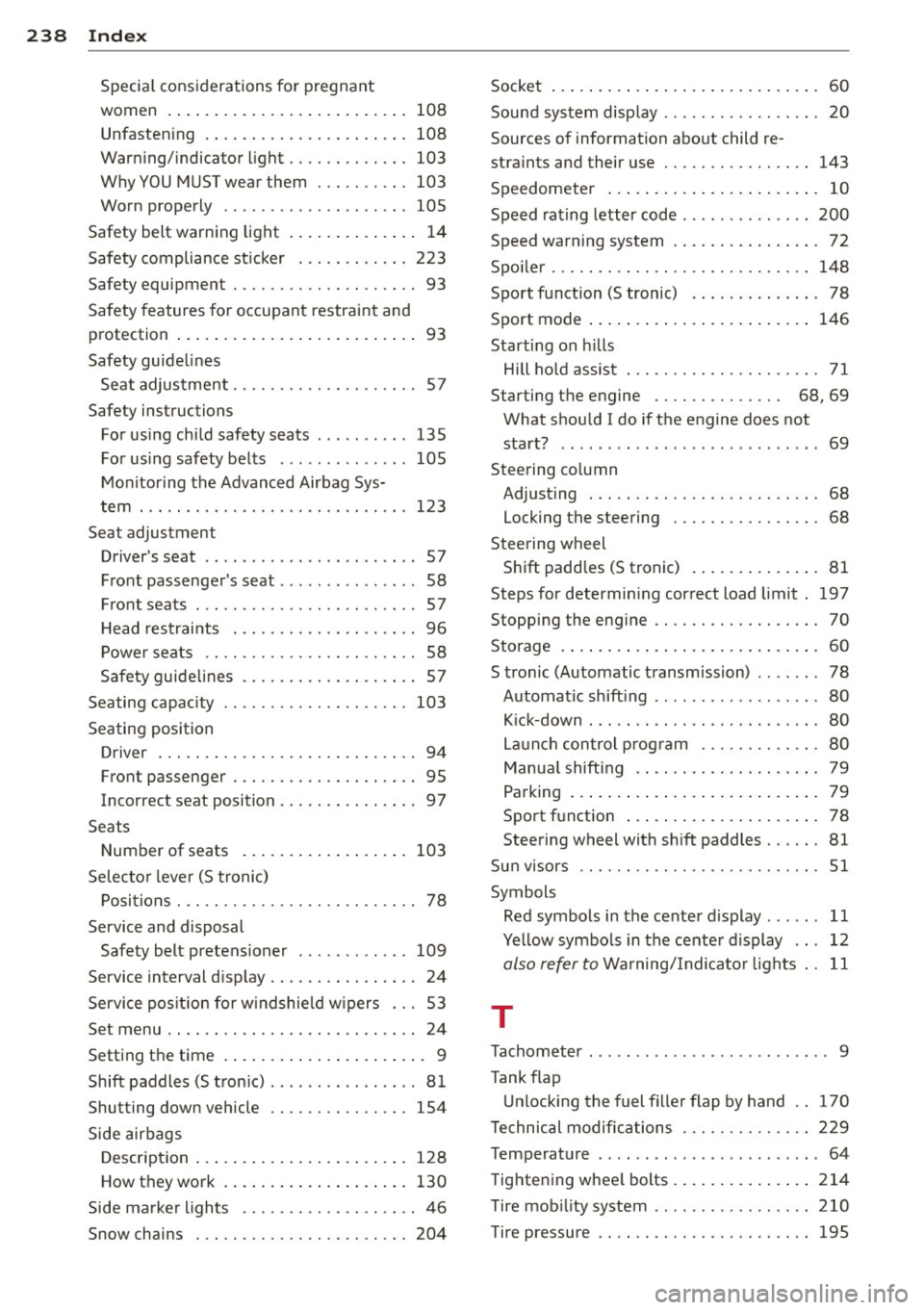
238 Index
Special considerations for pregnant
women .... ................ ..... . 108
Unfasten ing . ............. ... .... . 108
Warning/indicator light ...... .. .... . 103
Why YOU MUST wear them . .. .. .... . 103
Worn properly . . . . . . . . . . . . . . . . . . . . 105
Safety belt warning light ........ .... . . 14
Safety compliance sticker . .. .. .. .. .. . 223
Safety equipment . . . . . . . . . . . . . . . . . . . . 93
Safety features for occupant restraint and
protection . . . . . . . . . . . . . . . . . . . . . . . . . . 93
Safety guidelines
Seat adjustment . ....... .. .. .. .. .. .. 57
Safety instructions For using child safety seats ..... .. .. .
For using safety belts ..... .. .. .. .. .
Monitoring the Advanced Airbag Sys
tem
. .. .. .... ............. .. .... .
Seat adjustmen t 135
105
123
Driver 's seat .......... .... ... .. .. .. 57
Front passenger's seat . . . . . . . . . . . . . . . 58
Front seats . .............. ... .. ... . 57
H ead restraints . . . . . . . . . . . . . . . . . . . . 96
Power seats . . . . . . . . . . . . . . . . . . . . . . . 58
Safety guidelines
Seating capacity
Seating position 57
103
Driver ... .. .... ........... .. .... .. 94
Front passenger . . . . . . . . . . . . . . . . . . . . 95
Incorrect seat position . . . . . . . . . . . . . . . 97
Seats Number of seats 103
Selector lever (S tronic)
Positions . . . . . . . . . . . . . . . . . . . . . . . . . . 78
Service and disposal Safety belt pretens ioner . ........ .. . 109
Service interval display ....... ... .. .. .. 24
Service position for w indshield w ipers .. . 53
Se t menu .. .. ... .. ..... ... .... .. .. .. 24
Setting the time ............ ... .... .. . 9
Shift paddles (S tronic) .......... .. .... 81
Shutting down vehicle ...... .... .... . 154
Side airbags
Description ............... ... .... . 128
How they work . . . . . . . . . . . . . . . . . . . . 130
Side marker lights ......... .. .. .. .. .. 46
Snow chains 204 Socket
......... .. ............. ..... 60
Sound system display . . . . . . . . . . . . . . . . . 20
Sources of information about child re-
straints and their use ............ .... 143
Speedometer . . . . . . . . . . . . . . . . . . . . . . . 10
Speed rating letter code ........... ... 200
Speed warning system . . . . . . . . . . . . . . . . 72
Spoiler ... .. .. .. .. ............. .. .. 148
Sport function (S tronic) ...... ... .. .. . 78
Sport mode ..... .. .. .............. . 146
Starting on hills
Hill hold assist . .. ............. .... . 71
Starting the engine . . . . . . . . . . . . . . 68, 69
What should I do if the engine does not
start? ...... .. .. .. ..... ...... .. .. . 69
Steering co lumn
Adjusting . . . . . . . . . . . . . . . . . . . . . . . . . 68
Locking the steering . . . . . . . . . . . . . . . . 68
Steering wheel
Shift paddles (S tronic) .............. 81
Steps for determin ing correct load limit . 197
Stopping the engine ............. .... . 70
Storage ... ..... .. .. .............. .. 60
S tronic (Automatic transm ission) . . . . . . . 78
Automatic shift ing ................ .. 80
Kick-down . . . . . . . . . . . . . . . . . . . . . . . . . 80
Launch control program ........ .... . 80
Manual shifting . ................. .. 79
Parking ........................... 79
Sport function ... ................ .. 78
Steering wheel with shift paddles . .. .. . 81
Sun visors .. .. .. .. ............. .. .. . 51
Symbols Red symbols in the center display ..... . 11
Yellow symbols in the center display .. . 12
also refer to Warning/Indicator lights . . 11
T
Tachometer . . . . . . . . . . . . . . . . . . . . . . . . . . 9
Tank flap Unlocking the fuel filler flap by hand .. 170
T echnical modifications .......... .. .. 229
Temperature .. .. .. .. ........ ...... .. 64
Tightening wheel bolts ............ ... 214
T ire mobility system ... .......... .. .. 210
Tire pressure .... .. ............. .... 195